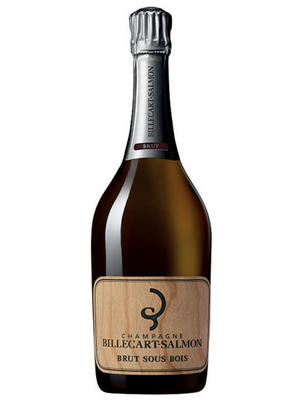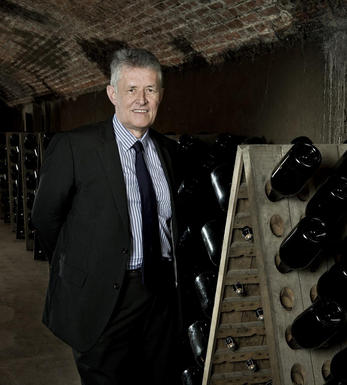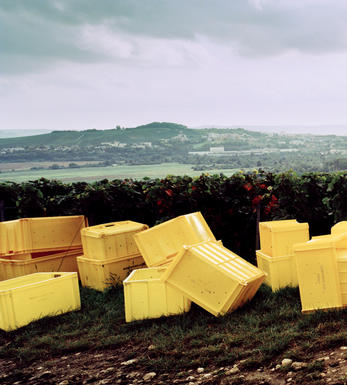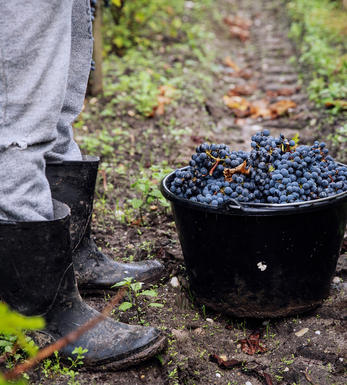
Champagne Billecart-Salmon, Sous Bois, Brut

Critics reviews
Rich, radiant and resonant, the Brut NV Sous Bois is wonderfully expressive. Dried orchard fruit, spice and chamomile build nicely with aeration. This release is based on 2015 with 40% reserve wines, a blend that works so well. Delicate floral and dried herb notes linger.
The dosage is 5 grams per litre. Disgorged: 2nd quarter 2022.
Mathieu Roland-Billecart has given his family’s Maison a much-needed kick in the rear end since taking over the reins in 2019. For years, Billecart-Salmon was a sleepy maison turning out gorgeous Champagnes at the top end but several undistinguished offerings at the lower level. Booking appointments or even getting a reply from the Maison was a challenge. That attitude was also pervasive at their US importer, T. Edward, because leadership, or lack of it, is a contagious force.
Things are remarkably different today. Roland-Billecart is young and dynamic, very much in touch with the modern world. Recent wines made under his tenure show more focus and quality than in the past because of greater selection and attention to detail. I was deeply impressed with what I tasted at the Maison during a recent visit and then more recently at my office in the US.
Drink 2023 - 2030
Antonio Galloni, Vinous.com (November 2023)
Made from one-third each Chardonnay, Pinot Noir and Pinot Meunier; 6 g/l dosage; L359333 15056M).
Bright yellow. Pungent orchard fruit and lemon curd scents are complemented by suggestions of vanilla, anise and smoky minerals. It is toasty and silky in texture, offering juicy pear and tangerine flavours, plus a deeper suggestion of candied fig on the back half. Closes sappy, focused and long, with repeating smokiness and strong mineral cut.
Josh Raynolds, Vinous.com (January 2015)
Disgorged in the second quarter of 2022 with a dosage of 4.9 grams per litre, Billecart-Salmon’s NV Brut Sous Bois emerges from the glass with aromas of orchard fruit, pear, peach, nuts and spring flowers. It's medium to full-bodied, clean and pure, with tangy acids and pastry notes on the finish. Elegant, linear and fruit-driven, this Champagne can be enjoyed right now or cellared for another year or two.
Base vintage: 2015 (60% of the blend and vinified in old barrels) with 40% of vins de réserve, the earliest vintage of which is 2006. It comprises 30% Pinot Noir sourced from Aÿ and Mareuil-sur-Aÿ, 40% Chardonnay from Côtes de Blancs grands crus and 30% Pinot Meunier from the Vallée de la Marne.
Drink 2023 - 2028
Yohan Castaing, Wine Advocate (April 2023)
A baby brother to Clos St-Hilaire, 100% barrel-fermented. One-third of each variety from selected parcels – older, lower-yielding parcels tend to be chosen for the Sous Bois. 52% grand cru grapes, 16% premier cru (across the whole portfolio; their Meunier isn’t grand or premier cru). One-third reserve wine. Malo blocked. Long lees-ageing (6–7 years). Slightly oxidative style – the most oxidative they make.
A richer mouthfeel as well as real bite. A savoury and yeasty note on the nose – almost slight Marmite (yeast extract). The oak is very well integrated and just frames the wine – the subtle note of spice comes in on the finish – slightly cedary note?
Drink 2021 - 2036
Alistair Cooper MW, JancisRobinson.com (December 2021)
Attractive nose of brioche, walnuts, salted almonds and baked apples. Some nutmeg. Lovely richness of flavor yet so bright, medium-bodied, with a salty freshness and very fine bubbles. Excellent length. 2016 base vintage with 26% reserve wines going back to 2006. 2.9g/L dosage.
Drink now
James Suckling, JamesSuckling.com (December 2023)
Fermented and aged over winter in second-hand small barrels and barrels seasoned in-house (although future editions will include wine from larger casks). Rich and inviting apricot and kernel notes, brown butter and nutty honey. Some soft strawberry and an appetising, tangy apple length, highly expressive but really rather polished and rounded out. One third each Pinot Noir, Meunier and Chardonnay.
Drink 2023 - 2028
Tom Hewson, Decanter.com (April 2023)
The NV Champagne Sous Bois Brut pours a medium yellow to deeper straw hue, and the nose is warming and more generous with notes of toast, red fruit of ripe raspberry, spice, and espresso. The palate is rounded, with a rich texture though dry, offering notes of orange peel and currant. It has a silky texture and a fairly long finish with ripe concentration. It is drinking well now and should drink well over the next 15 years.
Mathieu Roland-Billecart assumed the position of CEO at this estate in 2019 and represents the seventh generation in his family. The house is based in Maureuil sur Ay, which is also the location of the monopole vineyard of Clos Saint-Hillaire. They source from approximately 300 hectares of vines, of which they own a third. French and Stockingur barrels with medium toast are purchased new and seasoned at the house for three to five years before use.
About 80% of production is fermented and aged in stainless steel tanks. Only the best plots are fermented in barrels at cold temperatures before being transferred to stainless steel tanks for aging after no more than six months. None of the wines are aged in barrel, and they never allow for malolactic fermentation to occur in barrel.
Drink 2022 - 2037
Audrey Frick, JebDunnuck.com (November 2022)
About this WINE

Champagne Billecart-Salmon
Champagne Billecart-Salmon was founded in 1818 in the village of Mareuil-sur-Aÿ near Epernay. It remains family-owned and run; Mathieu Roland-Billecart represents the seventh generation here, following in the footsteps of founders Nicolas-François Billecart and Elisabeth Salmon.
A family tasting committee meets weekly, joined by chef du cave Florent Nys. The eight-person panel includes three generations of the family, notably including Jean Roland-Billecart (who alone has over 75 vintages of experience). Not one cuvée is released until every member of the committee agrees on the blend.
Billecart-Salmon is a large Champagne House, with around 100 hectares of vines of its own. The process of organic conversion for the vineyards was started in 2019. The house also buys fruit from growers covering another 300 hectares of vines. Most of the fruit comes from the Champagne sub-regions of Montagne de Reims, Vallée de la Marne and Côte des Blancs.

Brut Champagne
Brut denotes a dry style of Champagne (less than 15 grams per litre). Most Champagne is non-vintage, produced from a blend from different years. The non-vintage blend is always based predominately on wines made from the current harvest, enriched with aged wines (their proportion and age varies by brand) from earlier harvests, which impart an additional level of complexity to the end wine. Champagnes from a single vintage are labelled with the year reference and with the description Millésimé.
Non-vintage Champagnes can improve with short-term ageing (typically two to three years), while vintages can develop over much longer periods (five to 30 years). The most exquisite and often top-priced expression of a house’s style is referred to as Prestige Cuvée. Famous examples include Louis Roederer's Cristal, Moët & Chandon's Dom Pérignon, and Pol Roger's Cuvée Sir Winston Churchill.
Recommended Producers : Krug, Billecart Salmon, Pol Roger, Bollinger, Salon, Gosset, Pierre Péters, Ruinart

Champagne blend
Which grapes are included in the blend, and their proportion, is one of the key factors determining the style of most Champagnes. Three grapes are used - Pinot Noir, Chardonnay and Pinot Meunier.
26% of vineyards in Champagne are planted with Chardonnay and it performs best on the Côtes des Blancs and on the chalk slopes south of Epernay. It is relatively simple to grow, although it buds early and thus is susceptible to spring frosts. It produces lighter, fresher wines than those from Burgundy and gives finesse, fruit and elegance to the final blend. It is the sole grape in Blancs de Blancs, which are some of the richest long-lived Champagnes produced.
Pinot Noir accounts for nearly 40% of the plantings in Champagne and lies at the heart of most blends - it gives Champagne its body, structure, strength and grip. It is planted across Champagne and particularly so in the southern Aube district.
The final component is Pinot Meunier and this constitutes nearly 35% of the plantings. Its durability and resistance to spring frosts make the Marne Valley, a notorious frost pocket, its natural home. It ripens well in poor years and produces a soft, fruity style of wine that is ideal for blending with the more assertive flavours of Pinot Noir. Producers allege that Pinot Meunier lacks ageing potential, but this does not deter Krug from including around 15% of it in their final blends.


Buying options
Add to wishlist
Description
Rich, radiant and resonant, the Brut NV Sous Bois is wonderfully expressive. Dried orchard fruit, spice and chamomile build nicely with aeration. This release is based on 2015 with 40% reserve wines, a blend that works so well. Delicate floral and dried herb notes linger.
The dosage is 5 grams per litre. Disgorged: 2nd quarter 2022.
Mathieu Roland-Billecart has given his family’s Maison a much-needed kick in the rear end since taking over the reins in 2019. For years, Billecart-Salmon was a sleepy maison turning out gorgeous Champagnes at the top end but several undistinguished offerings at the lower level. Booking appointments or even getting a reply from the Maison was a challenge. That attitude was also pervasive at their US importer, T. Edward, because leadership, or lack of it, is a contagious force.
Things are remarkably different today. Roland-Billecart is young and dynamic, very much in touch with the modern world. Recent wines made under his tenure show more focus and quality than in the past because of greater selection and attention to detail. I was deeply impressed with what I tasted at the Maison during a recent visit and then more recently at my office in the US.
Drink 2023 - 2030
Antonio Galloni, Vinous.com (November 2023)
wine at a glance
Delivery and quality guarantee